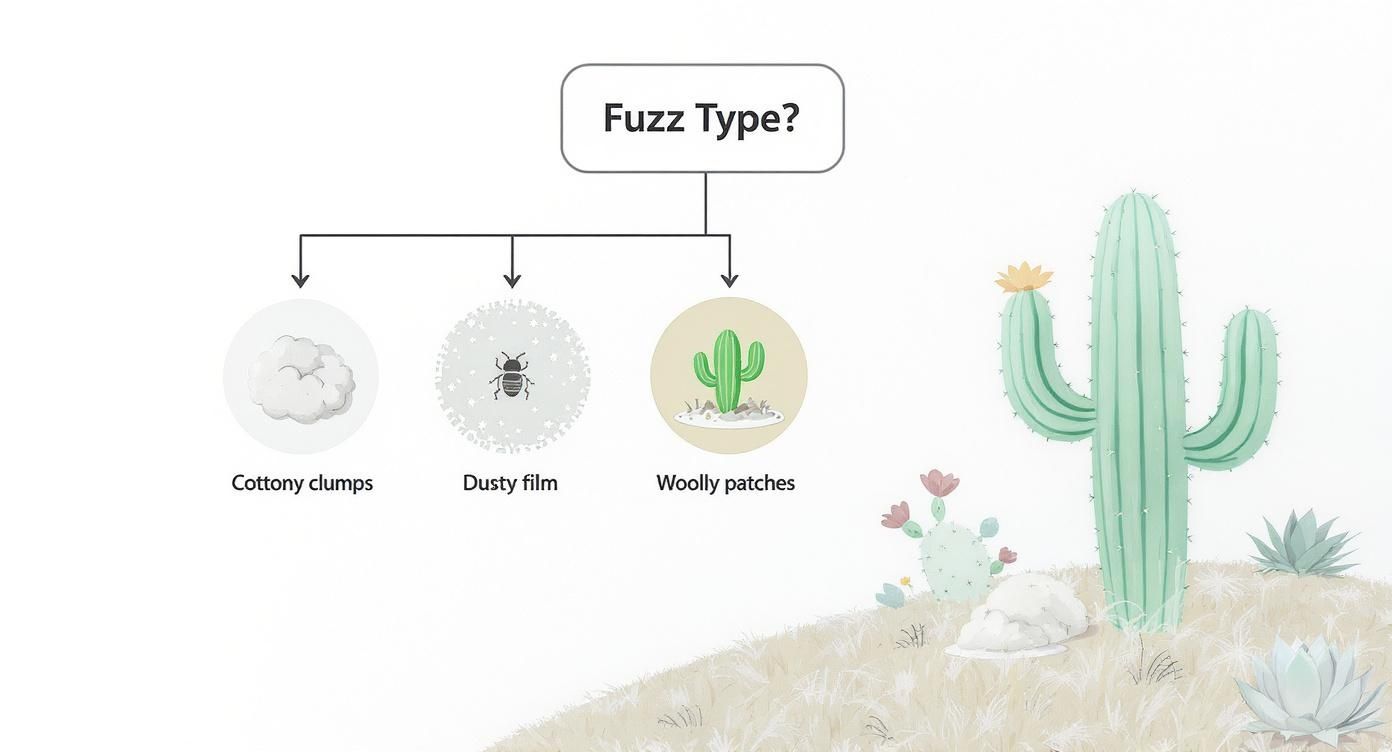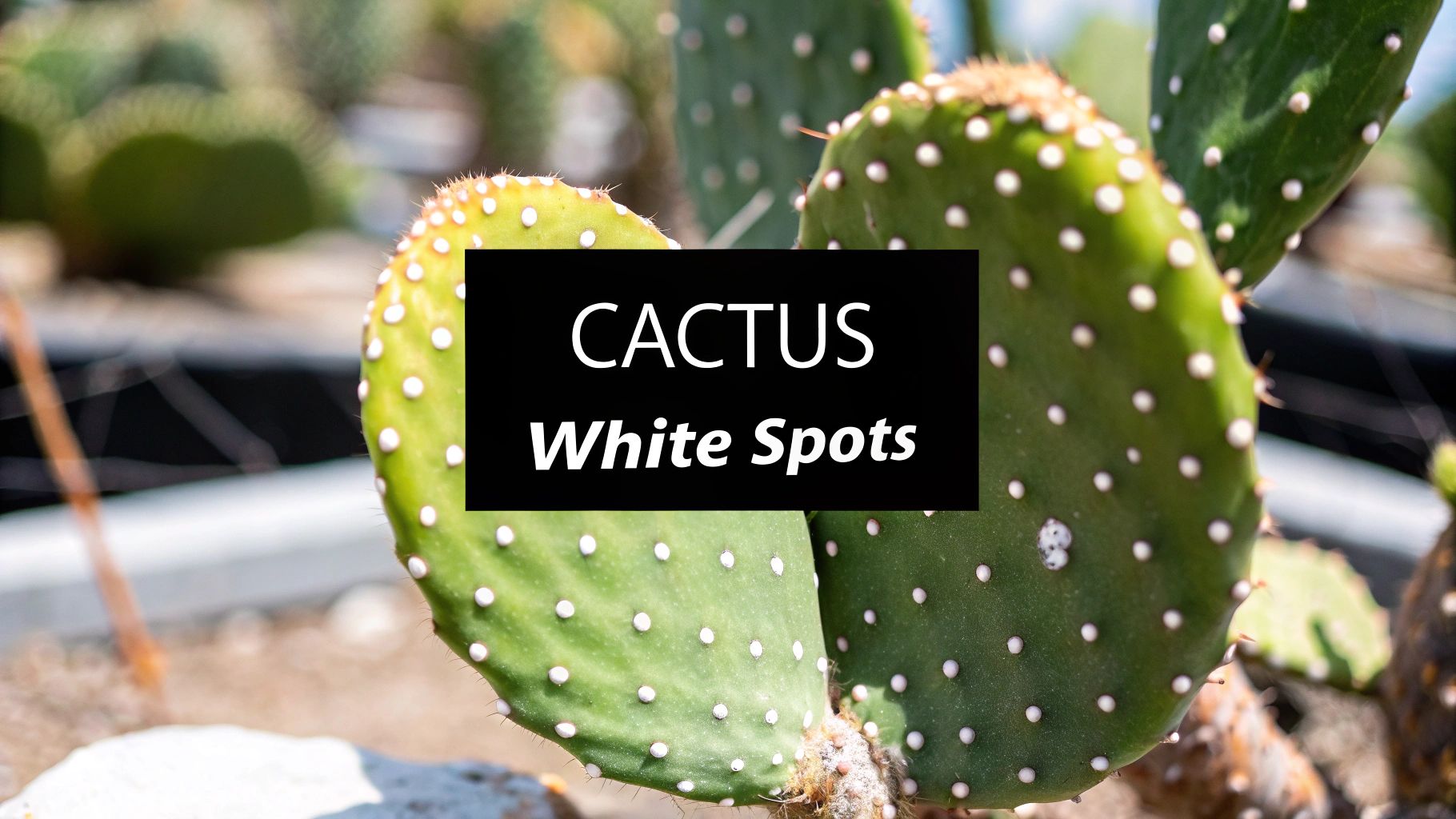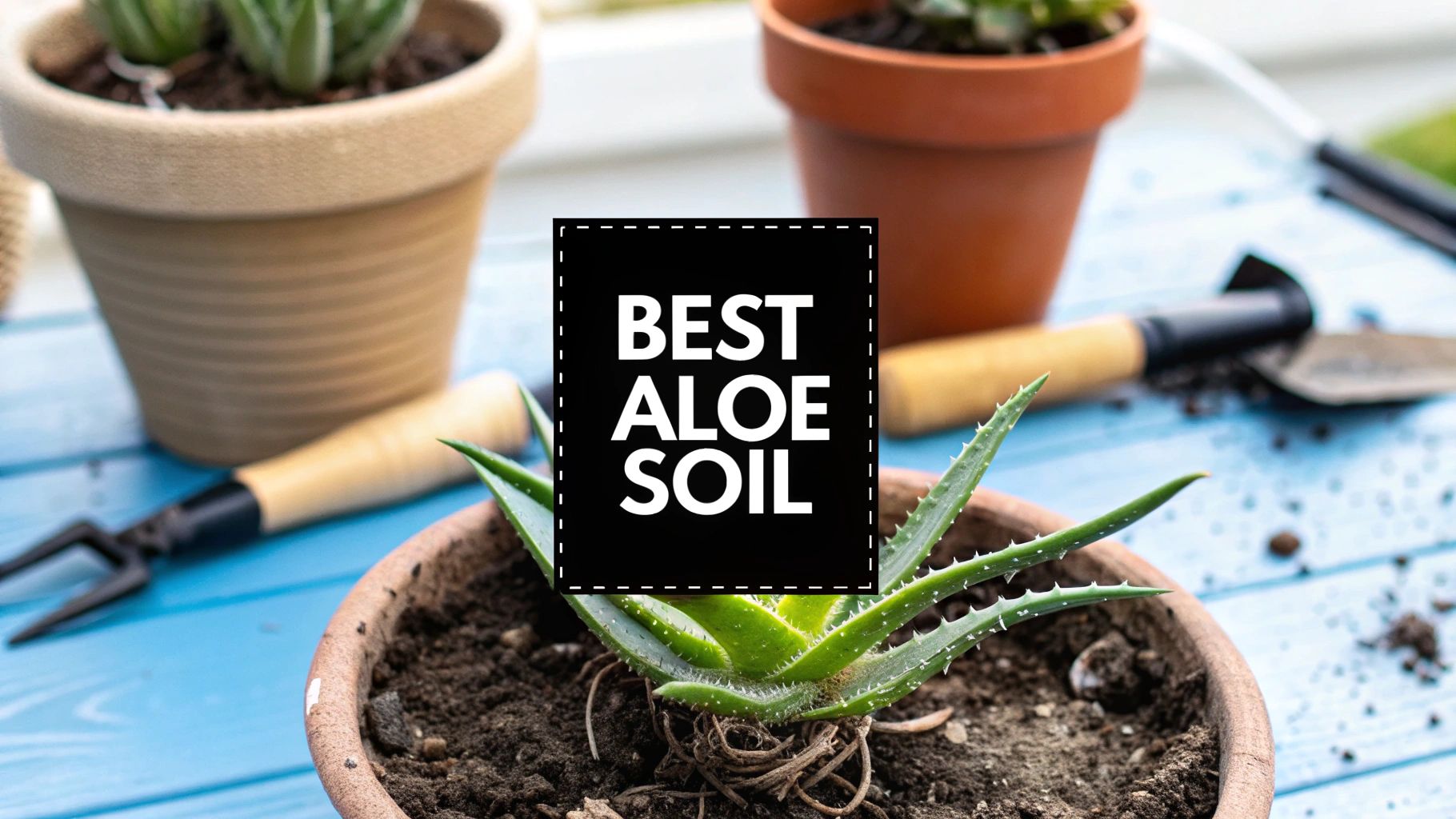It's a moment every cactus owner dreads: you're admiring your plant and spot little patches of white fuzz. Your mind might jump to the worst conclusion, but don't panic just yet. That mysterious white fuzz on cactus is almost always one of two things: a pest infestation or a fungal disease.
Figuring out which one you're up against is your first, most important step. Is it a cluster of mealybugs, or is it powdery mildew? Getting this right from the start means you can treat it correctly and get your cactus back to good health.
What Is This White Fuzz on My Cactus
When you first notice the white stuff, your instinct is to get rid of it. But hold on a second. Take a really close look at its texture and exactly where it’s showing up on the plant. Sometimes, what looks like a problem is actually a completely normal, healthy feature of certain cactus species.
Pest, Fungus, or Natural Feature
More often than not, those cotton-like clumps are mealybugs. I've seen them countless times. These tiny insects love to hide in protected spots—think the joints where pads meet or deep down in the spine clusters. They secrete a waxy, sticky substance that looks exactly like tiny bits of cotton.
The other common culprit is powdery mildew. This is a fungus, and it looks quite different. Instead of distinct clumps, mildew presents as a dusty, almost web-like film that spreads across the cactus surface. It's like someone lightly dusted your plant with flour. This fungus loves high humidity and stagnant air, which is why good airflow is so crucial for cacti.
But here’s where it gets interesting: some white fuzz is perfectly natural. Ever seen a Peruvian old man cactus (Espostoa lanata)? That dense, woolly coating is meant to be there; it's the plant's natural sunblock. Similarly, the white fluff on some cholla (Cylindropuntia spp.) and prickly pear (Opuntia spp.) is often from cochineal scale insects, which create a waxy shield for protection. Learning about the unique traits of desert plants can save you a lot of worry.
This decision tree can help you quickly sort out what you're looking at.

As you can see, the biggest clue is telling the difference between those cottony clumps and a fine, dusty film.
Comparing the Common Causes
To help you get a quick and accurate diagnosis, I've put together a simple comparison table. This breaks down the key differences between the most common causes of white fuzz.
Identifying the Cause of White Fuzz on Your Cactus
| Cause | Appearance | Location on Cactus | Is it Harmful? |
|---|---|---|---|
| Mealybugs | Small, white, cottony clumps; sticky residue | Hiding in crevices, at the base of spines, or where pads/stems connect | Yes, they feed on plant sap and can cause significant damage. |
| Powdery Mildew | A thin, dusty, web-like white or grey film | Spreads across the surface of the plant's skin (pads, stems) | Yes, it's a fungal disease that can weaken and eventually kill the plant. |
| Natural Wool/Areoles | Soft, fibrous, wool-like tufts that grow with the plant | From the areoles (where spines emerge); can cover the entire cactus body | No, this is a healthy, protective feature for certain species. |
This table should make it much easier to pinpoint the problem.
Pests like mealybugs often leave behind other clues. For instance, you might see yellowing spots on the cactus where they've been feeding. If you're seeing discoloration along with the fuzz, that's a huge red flag for an infestation. If you want to learn more, check out our guide on why your cactus is turning yellow.
Key Takeaway: The texture of the white fuzz is your best clue. Mealybugs create distinct, cotton-like tufts, powdery mildew forms a thin, dusty layer, and natural cactus wool is fibrous and integrated into the plant's structure.
Getting a handle on these subtle differences means you can act quickly and use the right approach. A fast, accurate diagnosis saves you from using the wrong treatments and helps you fix the root cause, keeping your cactus healthy for years to come.
Getting to Know the Common Cactus Pests

Spotting that white fuzz is the first step, but figuring out what it is unlocks the right way to fix it. More often than not, the culprits behind this cottony mess are sap-sucking insects, usually mealybugs or cochineal scale. This isn't just lint—it’s an active colony working to drain the life from your plant.
These tiny pests survive by piercing the cactus's skin and feeding on the nutrient-rich sap inside. Over time, this constant feeding weakens the plant, which you might notice as slowed growth, yellowing pads, or just a general look of poor health. What starts as a small, easy-to-miss spot can quickly escalate into a serious infestation.
Mealybugs: The Hidden Threat
Mealybugs are experts at staying out of sight. Their waxy, white coating is the perfect camouflage, making them look like a harmless bit of fuzz while they hide in the most protected parts of your cactus.
You'll almost always find them hunkered down in hard-to-reach places:
- Deep in the joints where cactus pads or stems meet.
- Right at the base of the plant, sometimes even just below the soil.
- Tucked away under a dense cluster of spines.
This knack for hiding is what makes them so difficult to control. A quick, casual look might not reveal them at all, which is why a careful inspection is a must as soon as you see any sign of white fuzz on cactus.
The real problem is how fast they multiply. A female mealybug can lay hundreds of eggs in one of those cottony sacs. So, what looks like one or two bugs can explode into a massive population in just a matter of weeks. This is exactly why catching them early is the key to preventing them from overrunning your cactus and spreading to its neighbors.
Expert Insight: The second you confirm mealybugs on one plant, get it away from your other cacti immediately. In their early "crawler" stage, they are surprisingly mobile and will happily move from pot to pot, turning one isolated problem into a collection-wide headache.
Cochineal Scale: A Deceptive Fuzz
Cochineal scale looks a lot like mealybugs, producing a similar white, waxy coating for protection. These pests are particularly drawn to Prickly Pear (Opuntia) and Cholla (Cylindropuntia) species. And while they're famous for being the source of a natural red dye, for a cactus enthusiast, they're nothing but trouble.
Just like mealybugs, they feed on sap. The difference is they tend to stay put once they find a good spot. The waxy fluff they create isn't just for hiding, either. For cacti like Opuntia, the green pads are essential for photosynthesis. When a cochineal scale infestation gets thick, that white coating can block so much sunlight that it seriously impacts the plant's health, sometimes stunting its growth by up to 30% in severe cases.
Getting a handle on how these pests operate is fundamental to treating them effectively. To deepen your knowledge of plant health, you can also look into resources that cover various plant diseases and pests. Once you understand how they feed, hide, and reproduce, you can stop just wiping away the fuzz and start using a real strategy to break their lifecycle and keep your cactus safe for good.
How to Effectively Remove White Fuzz
https://www.youtube.com/embed/gXPkIA0TGbM
Once you’ve figured out whether you’re dealing with a pest or a fungus, you need to act fast. The absolute first thing you should do is isolate the affected cactus. Seriously, don't skip this. It’s the single best way to keep a small problem from turning into a full-blown infestation across your entire plant collection.
Find a spot for your patient—a separate room or a sheltered area outside, far away from any other green friends. This quarantine isn't just about treatment; it's a chance to really observe the plant without putting others at risk. Now you can get down to business.
Manual Removal Techniques
If you've caught an infestation early, you might be surprised to learn that your best tool is already in your medicine cabinet. For small clusters of mealybugs, a cotton swab and some rubbing alcohol are remarkably effective. It's a targeted approach that lets you zap the pests without soaking the whole cactus.
Here's my go-to method:
- Grab a Q-tip or cotton swab and dip it into 70% isopropyl alcohol.
- Gently dab every single white, fuzzy clump you see. The alcohol cuts right through the pests' waxy, protective coating and kills them instantly.
- Getting into those tight spots between the spines can be tricky. A small, soft paintbrush or even an old toothbrush dipped in alcohol works wonders for this.
After you've treated the visible spots, you can follow up with a strong spray of water to physically blast off any dead bugs and their sticky residue. Make sure you check every nook and cranny, especially under pads and right at the base of the plant—pests love to hide there. For minor issues, this is often all it takes.
Broader Spray Treatments
When the white fuzz is more widespread, either from a bigger mealybug family or a case of powdery mildew, it's time for a treatment with better coverage. You’ve got options here, from simple DIY sprays to store-bought solutions, and both work well when you use them right.
An easy and gentle homemade option is an insecticidal soap spray. Just mix one teaspoon of a mild dish soap (make sure it doesn’t have bleach or heavy degreasers) into a quart of water. This simple concoction works by breaking down the pest's exoskeleton, which leads to dehydration.
Another fantastic organic weapon is neem oil. I love it because it’s a double-whammy, acting as both a pesticide and a fungicide. You'll want to mix it according to the label's directions—typically, it’s about one teaspoon of neem oil and a half teaspoon of mild soap (which helps the oil and water mix) per quart of water.
Important Tip: Before you go all-in with any spray, test it on a small, hidden part of your cactus first. Wait a full 24 hours to make sure there's no bad reaction, like chemical burn. It's a little bit of patience that can save you a lot of heartache.
When looking for gentle ways to tackle pests, exploring organic aphid control strategies can offer some great transferable knowledge. The core ideas behind using organic solutions often apply to many common houseplant pests, not just aphids.
In the worst-case scenarios, a severe infestation can mean the soil itself is compromised. Pests often lay their eggs in the potting mix, which just starts the whole frustrating cycle over again. If you suspect this is the case, repotting is your best bet. Learning how to repot cacti properly will give your plant a clean slate in a new pot with fresh, sterile soil, tackling the problem from the roots up.
Advanced Solutions for Stubborn Infestations

Sometimes, you do everything right. You’ve swabbed with alcohol, you’ve sprayed with soap, but the white fuzz on cactus just won't quit. When a pest problem becomes a full-blown invasion, it's time to stop fighting a surface battle and bring out the big guns.
These next steps are for when you’re facing a persistent infestation that seems to be winning. We're talking about methods that work from the inside out or introduce a whole new element to the fight. It's always best to start small, but don't be afraid to escalate your approach when your cactus's life is on the line.
Systemic Insecticides for Deep Protection
When mealybugs have tucked themselves into every nook and cranny—and maybe even the root system—a systemic insecticide can feel like a miracle. Unlike a contact spray that has to physically touch the pest, a systemic is absorbed directly by the plant, turning its own sap toxic to anything trying to feed on it.
Usually, you'll apply these as a soil drench. Just mix the product with water according to the instructions and water your cactus as usual. The roots will pull the insecticide up and circulate it everywhere. When a mealybug takes a bite, it's game over. This is incredibly effective for getting at pests you can't see or reach.
But remember, these are serious chemicals and you need to treat them with respect.
- Safety First: Always handle systemics in a well-ventilated space and wear protective gloves.
- Pet and Child Concerns: These products are often highly toxic if ingested. If you have curious pets or little ones at home, a systemic might not be the safest option for your indoor plants.
- Follow Directions: Read the label. Then read it again. Using more than the recommended dose can seriously damage or even kill your cactus.
Crucial Takeaway: Systemic treatments are a powerful internal defense against heavy infestations. Their toxicity demands caution, so follow all safety guidelines to the letter, especially if you have pets or children in the house.
Biological Controls for Outdoor Cacti
If your cacti live outdoors, you have a fantastic and eco-friendly option: let nature handle it. You can introduce beneficial insects to your garden, creating a tiny ecosystem that keeps pests in check all on its own. This is often called biological control.
The most well-known garden heroes are ladybugs. These little predators are absolute machines when it comes to eating common cactus pests like mealybugs and aphids. You can buy a container of live ladybugs at many garden centers or order them online. For the best results, release them onto your affected cacti around dusk; this encourages them to stick around instead of flying off immediately. It’s a wonderfully effective way to manage that white fuzz on cactus without reaching for a chemical spray.
Proactive Care to Keep Your Cactus Healthy
Let's be honest, dealing with pests and diseases is no fun. The absolute best way to handle that white fuzz is to make sure it never shows up in the first place. Think of it this way: a happy, thriving cactus is its own best defense. A strong plant can shrug off the kinds of problems that would devastate a weak or stressed one.
By focusing on the fundamentals, you're not just reacting to problems; you're building a fortress of health around your plant. The goal is to create an environment so perfectly suited to your cactus that mealybugs and mildew don't even get a foothold.
Master the Basics of Cactus Care
When it comes down to it, keeping a cactus healthy really revolves around three key things: sunlight, water, and air. Nailing these basics is your first and most important step in preventing that dreaded white fuzz on cactus.
-
Sunlight: Cacti are sun-worshippers. Most varieties need at least six hours of bright, direct sun every single day. If your plant is indoors, a south-facing window is usually your best bet. A cactus starved for light becomes weak and stretched out, basically rolling out the welcome mat for pests.
-
Watering: This is where so many people go wrong. Overwatering is probably the single biggest killer of cacti, and it creates the exact damp, unhappy environment that fungus loves. The rule is simple: let the soil become bone dry all the way through before you even think about watering again. For a deeper dive, you can learn more about properly watering cactus plants to avoid the common mistakes.
-
Air Circulation: Don't underestimate the power of a good breeze. Stagnant, humid air is a breeding ground for powdery mildew. If your collection is indoors, especially in a more humid room, just cracking a window or using a small fan on a low setting can work wonders.
A Note on Soil: Whatever you do, don't plant your cactus in regular potting soil. It's a death sentence. It holds way too much water. You need a fast-draining cactus or succulent mix. I often amend mine with extra perlite or pumice just to be sure it drains perfectly.
The Importance of Regular Inspections
Even the best-cared-for plants can sometimes attract an unwelcome guest. That’s why making a habit of regular check-ups is one of the smartest things you can do as a plant owner. Spotting a problem when it's just a tiny speck is a thousand times easier than dealing with a full-blown infestation.
Try to give your cacti a close look at least once a week. And I don't mean a quick glance from across the room. Get right up in there. Check the little nooks where the pads or stems join, look around the base near the soil, and peek between the spines. These are the sneaky hiding spots where mealybugs love to set up camp.
This little ritual only takes a couple of minutes, but it can save you a world of trouble. You’ll get to know your plants so well that you’ll spot trouble long before it becomes a crisis.
To help you stay on track, here's a quick checklist summarizing the ideal environment for preventing pests and disease.
Preventive Care Checklist for Healthy Cacti
This table breaks down the key care aspects and what you should be aiming for to keep your cacti robust and resilient against common issues like white fuzz.
| Care Aspect | Optimal Condition | Prevention Goal |
|---|---|---|
| Light | 6+ hours of direct sun daily | Promotes strong, healthy growth that is less attractive to pests. |
| Watering | Soil dries completely between waterings | Prevents root rot and eliminates the moist conditions that fungi need. |
| Soil | Fast-draining cactus/succulent mix | Ensures roots don't sit in water, discouraging both rot and soil pests. |
| Airflow | Good air circulation around the plant | Deters fungal spores (like powdery mildew) from settling and growing. |
| Inspections | Weekly, close-up visual checks | Allows for early detection and immediate removal of pests or disease. |
By consistently providing these conditions, you're not just keeping your cactus alive—you're creating an environment where it can truly thrive, making it an uninviting target for any fuzzy invaders.
Frequently Asked Questions

After you've dealt with the immediate problem, a few questions often pop up. Let's run through some of the most common things cactus growers wonder about when they find that pesky white stuff.
Can White Fuzz Spread to Other Houseplants?
Unfortunately, yes. Pests like mealybugs aren't picky eaters; they’ll happily jump ship to your other houseplants, especially succulents or any plant with soft, lush leaves.
This is exactly why quarantining the affected plant immediately is a non-negotiable first step. Think of it as protecting the rest of your collection.
Fungal problems, like powdery mildew, are even sneakier. The spores are airborne, so they can easily drift to neighboring plants and take hold if the conditions are right. Improving the air circulation around your plants can make a huge difference in preventing this from happening.
How Often Should I Treat an Infested Cactus?
This really comes down to what you're fighting and how bad it is. If you’re manually dabbing mealybugs with isopropyl alcohol, you'll want to check your cactus every couple of days to catch any stragglers you missed.
For broader treatments like neem oil or insecticidal soap, a good rule of thumb is to spray every 5-7 days for at least two or three weeks. This schedule is designed to interrupt the pest life cycle, ensuring you get the newly hatched insects before they have a chance to grow up and lay more eggs. Of course, always read the label on any product you buy.
Key Insight: Consistency is your best weapon. A single, aggressive treatment can stress your cactus and might not solve the problem. Gentle, repeated applications are far more effective for wiping out pests for good.
Is the Red Dye from Cochineal Harmful to the Plant?
It’s pretty alarming when you squish a tiny white bug and a bright red smear appears, right? That's the cochineal scale, the source of natural carmine dye.
The good news is that the red liquid itself doesn't harm your cactus. The real problem is what the insect is doing: sucking the sap out of your plant. This feeding weakens it over time, so while the dye is harmless, seeing it is a sure sign you’ve got pests that need to go.
At The Cactus Outlet, we believe a healthy cactus is a happy cactus. Explore our collection of beautiful, high-quality cacti and find the perfect addition to your home today. https://www.cactusoutlet.com




